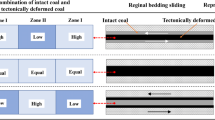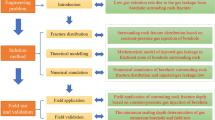Abstract
Although it is a well-accepted belief in the petroleum industry that horizontal well productivity can be limited by the pressure drop within the wellbore, little has been reported regarding how this pressure drop affects gas extraction from a coal seam and its further effects on mitigating coal and gas outburst dangers in coal. One of the major reasons for this scarcity is that the pressure-drop distribution in horizontal drainage boreholes is difficult to obtain. In this study, measurements of pressure drops in 54 drainage boreholes were performed in the No. 21 coal seam, which is the primary mining layer of Jiulishan Mine and poses a strong danger of coal and gas outbursts. Next, a coupled governing finite-element model, which includes the pressure drop in the borehole, Darcy flow in fractures, gas diffusion in the matrix blocks, and the dynamic evolution of the permeability of coal, was developed and implemented using a finite-element method to quantify the pressure-drop effects. Field tests of the pressure drops indicate that the pressure increases in a parabolic form with the increasing depth of the borehole, and lower outer end pressure is associated with larger pressure increments. The numerical results indicate that the pressure drop does affect the coal seam gas extraction, the pressure around the borehole increases with increasing borehole depth, and the increment of the pressure becomes larger when the borehole’s drainage effect is enhanced. However, the impact is small and can be ignored in engineering.











Similar content being viewed by others
References
Amna G, Hiroshi T (2011) Experimental study and modeling of pressure loss for foam-cuttings mixture flow in horizontal pipe. J Hydrodyn Ser B 23(4):431–438
Awwad A, Xin R, Dong Z, Ebadian M, Soliman H (1995) Measurement and correlation of the pressure drop in air-water two-phase flow in horizontal helicoidal pipes. Int J Multiph Flow 21(4):607–619
Badie S, Hale C, Lawrence C, Hewitt G (2000) Pressure gradient and holdup in horizontal two-phase gas–liquid flows with low liquid loading. Int J Multiph Flow 26(9):1525–1543
Dikken B (1990) Pressure drop in horizontal wells and its effect on production performance. J Petrol Technol 42(11):1426–1433
Firoozabadi HM, Rahimzade K, Pourafshari P (2011) Field validation of pressure drop models in perforated section of gas condensate wells. J Nat Gas Sci Eng 3(2):375–381
Gilman A, Beckie R (2000) Flow of coal-bed methane to a gallery. Transp Porous Media 41(1):1–16
Gong X, Tian J, Wang J (2013) First integral method for an oscillator system. Electron J Differ Equ 96:1–12
Guo B (2010) Corrections to horizontal drain hole productivity equations for wellbore friction effect. J Petrol Sci Eng 70(3):344–349
Hu G, Wang H, Fan X, Yuan Z, Hong S (2009) Mathematical model of coalbed gas flow with Klinkenberg effects in multi-physical fields and its analytic solution. Transp Porous Media 76(3):407–420
Jin R, Chen W, Simpson TW (2001) Comparative studies of metamodelling techniques under multiple modelling criteria. Struct Multidiscip Optim 23(1):1–13
Jones FO, Owens W (1980) A laboratory study of low-permeability gas sands. J Petrol Technol 32(9):1631–1640
Klinkenberg L (1941) The permeability of porous media to liquids and gases. In: Drilling and production practice. American Petroleum Institute, New York, pp 200–213
Li GZ, Yao YD, Dong SP (2007) A physical model for predicting the pressure drop of gas-liquid slug flow in horizontal pipes. J Hydrodyn 19(6):736–742. doi:10.1016/s1001-6058(08)60011-6
Mian C, Zhida C (1999) Effective stress laws for multi-porosity media. Appl Math Mech 20(11):1207–1213
Mora C, Wattenbarger R (2009) Analysis and verification of dual porosity and CBM shape factors. J Can Pet Technol 48(2):17–21
Multiphysics C (2008) User’s guide, version 3.5 a. COMSOL AB
Novy R (1995) Pressure drops in horizontal wells: when can they be ignored? SPE Reserv Eng 10(1):29–35
Olivier JG, Van Aardenne JA, Dentener FJ, Pagliari V, Ganzeveld LN, Peters JA (2005) Recent trends in global greenhouse gas emissions: regional trends 1970–2000 and spatial distribution of key sources in 2000. Environ Sci 2(2–3):81–99
Ouyang L-B, Aziz K (2000) A homogeneous model for gas–liquid flow in horizontal wells. J Petrol Sci Eng 27(3):119–128
Pabst W, Gregorová E, Tichá G (2006) Elasticity of porous ceramics—A critical study of modulus–porosity relations. J Eur Ceram Soc 26(7):1085–1097
Palmer I, Mansoori J (1998) How permeability depends on stress and pore pressure in coalbeds: a new model. SPE Reservoir Eval Eng 1(6):539–544
Qu P, Shen R, Fu L, Wang Z (2011) Time delay effect due to pore pressure changes and existence of cleats on borehole stability in coal seam. Int J Coal Geol 85(2):212–218. doi:10.1016/j.coal.2010.10.013
Robertson E (2005) Modeling permeability in coal using sorption-induced strain data. In: SPE annual technical conference and exhibition
Sarica C, Haciislamoglu M, Raghavan R, Brill J (1994) Influence of wellbore hydraulics on pressure behavior and productivity of horizontal gas wells. In: SPE annual technical conference and exhibition
Shen B, Liu J, Zhang H (2007) The technical measures of gas control in China coal mines [J]. J China Coal Soc 7:000
Su Z, Gudmundsson J (1998) Perforation inflow reduces frictional pressure loss in horizontal wellbores. J Petrol Sci Eng 19(3):223–232
Valliappan S, Zhang W (1996) Numerical modelling of methane gas migration in dry coal seams. Int J Numer Anal Meth Geomech 20(8):571–593
Wang Z-M, Xiao J-N, Wang X-Q, Wei J-G (2011) Experimental study for pressure drop of variable mass flow in horizontal well. Shiyan Liuti Lixue/J Exp Fluid Mech 25(5):26–29
Wang J, Kabir A, Liu J, Chen Z (2012) Effects of non-Darcy flow on the performance of coal seam gas wells. Int J Coal Geol 93:62–74
Wu Y-S, Karsten P (1998) Gas flow in porous media with Klinkenberg effects. Transp Porous Media 32(1):117–137
Wu Y, Liu J, Elsworth D, Chen Z, Connell L, Pan Z (2010) Dual poroelastic response of a coal seam to CO2 injection. Int J Greenhouse Gas Control 4(4):668–678
Yao X, Cheng G, Shi B (2010) Analysis on gas extraction drilling instability and control method of pore-forming in deep surrounding-rock with weak structure. J China Coal Soc 35(12):2073–2081
Yu L-X, Zhou S-T, Zhang Q (2001) Pressure gradient model for variable mass fluid flow in horizontal wellbore. Shiyou Daxue Xuebao/J Univ Petroleum China 25(4):47–48
Yuan H, Sarica C, Brill J (1996) Effect of perforation density on single phase liquid flow behavior in horizontal wells. In: International conference on horizontal well technology
Zhang J, Roegiers J-C, Bai M (2004) Dual-porosity elastoplastic analyses of non-isothermal one-dimensional consolidation. Geotech Geol Eng 22(4):589–610
Zhang H, Liu J, Elsworth D (2008) How sorption-induced matrix deformation affects gas flow in coal seams: a new FE model. Int J Rock Mech Min Sci 45(8):1226–1236
Zhu W, Liu J, Sheng J, Elsworth D (2007) Analysis of coupled gas flow and deformation process with desorption and Klinkenberg effects in coal seams. Int J Rock Mech Min Sci 44(7):971–980
Acknowledgments
This work was supported by the Natural Science Foundation for the Youth of China (No. 41202118, No. 51204173), the National Basic Research Program of China (973 Program, No. 2011CB201204), and the Natural Science Foundation for the Youth of China (No. 51304204).
Author information
Authors and Affiliations
Corresponding author
Rights and permissions
About this article
Cite this article
Liu, Q., Cheng, Y. Measurement of pressure drop in drainage boreholes and its effects on the performance of coal seam gas extraction: a case study in the Jiulishan Mine with strong coal and gas outburst dangers. Nat Hazards 71, 1475–1493 (2014). https://doi.org/10.1007/s11069-013-0957-7
Received:
Accepted:
Published:
Issue Date:
DOI: https://doi.org/10.1007/s11069-013-0957-7




